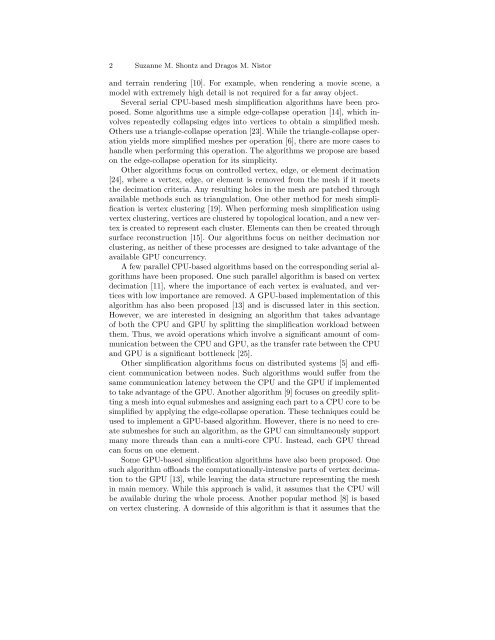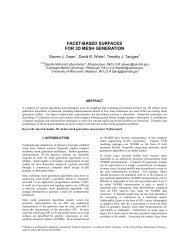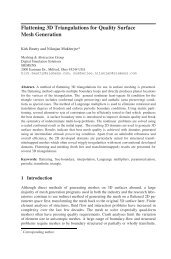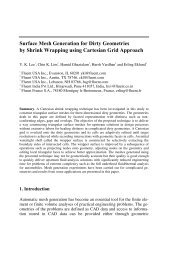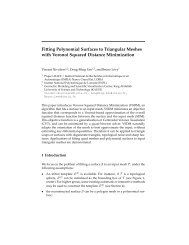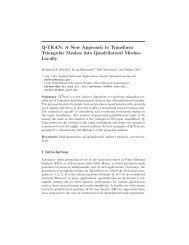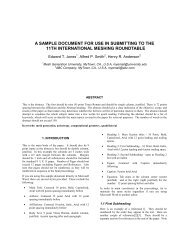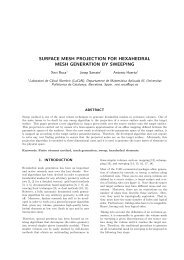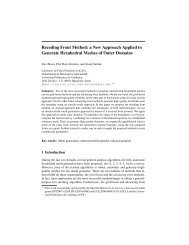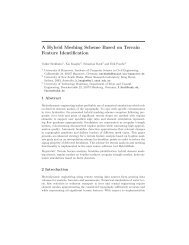CPU-GPU Algorithms for Triangular Surface Mesh Simplification
CPU-GPU Algorithms for Triangular Surface Mesh Simplification
CPU-GPU Algorithms for Triangular Surface Mesh Simplification
You also want an ePaper? Increase the reach of your titles
YUMPU automatically turns print PDFs into web optimized ePapers that Google loves.
2 Suzanne M. Shontz and Dragos M. Nistorand terrain rendering [10]. For example, when rendering a movie scene, amodel with extremely high detail is not required <strong>for</strong> a far away object.Several serial <strong>CPU</strong>-based mesh simplification algorithms have been proposed.Some algorithms use a simple edge-collapse operation [14], which involvesrepeatedly collapsing edges into vertices to obtain a simplified mesh.Others use a triangle-collapse operation [23]. While the triangle-collapse operationyields more simplified meshes per operation [6], there are more cases tohandle when per<strong>for</strong>ming this operation. The algorithms we propose are basedon the edge-collapse operation <strong>for</strong> its simplicity.Other algorithms focus on controlled vertex, edge, or element decimation[24], where a vertex, edge, or element is removed from the mesh if it meetsthe decimation criteria. Any resulting holes in the mesh are patched throughavailable methods such as triangulation. One other method <strong>for</strong> mesh simplificationis vertex clustering [19]. When per<strong>for</strong>ming mesh simplification usingvertex clustering, vertices are clustered by topological location, and a new vertexis created to represent each cluster. Elements can then be created throughsurface reconstruction [15]. Our algorithms focus on neither decimation norclustering, as neither of these processes are designed to take advantage of theavailable <strong>GPU</strong> concurrency.A few parallel <strong>CPU</strong>-based algorithms based on the corresponding serial algorithmshave been proposed. One such parallel algorithm is based on vertexdecimation [11], where the importance of each vertex is evaluated, and verticeswith low importance are removed. A <strong>GPU</strong>-based implementation of thisalgorithm has also been proposed [13] and is discussed later in this section.However, we are interested in designing an algorithm that takes advantageof both the <strong>CPU</strong> and <strong>GPU</strong> by splitting the simplification workload betweenthem. Thus, we avoid operations which involve a significant amount of communicationbetween the <strong>CPU</strong> and <strong>GPU</strong>, as the transfer rate between the <strong>CPU</strong>and <strong>GPU</strong> is a significant bottleneck [25].Other simplification algorithms focus on distributed systems [5] and efficientcommunication between nodes. Such algorithms would suffer from thesame communication latency between the <strong>CPU</strong> and the <strong>GPU</strong> if implementedto take advantage of the <strong>GPU</strong>. Another algorithm [9] focuses on greedily splittinga mesh into equal submeshes and assigning each part to a <strong>CPU</strong> core to besimplified by applying the edge-collapse operation. These techniques could beused to implement a <strong>GPU</strong>-based algorithm. However, there is no need to createsubmeshes <strong>for</strong> such an algorithm, as the <strong>GPU</strong> can simultaneously supportmany more threads than can a multi-core <strong>CPU</strong>. Instead, each <strong>GPU</strong> threadcan focus on one element.Some <strong>GPU</strong>-based simplification algorithms have also been proposed. Onesuch algorithm offloads the computationally-intensive parts of vertex decimationto the <strong>GPU</strong> [13], while leaving the data structure representing the meshin main memory. While this approach is valid, it assumes that the <strong>CPU</strong> willbe available during the whole process. Another popular method [8] is basedon vertex clustering. A downside of this algorithm is that it assumes that the


